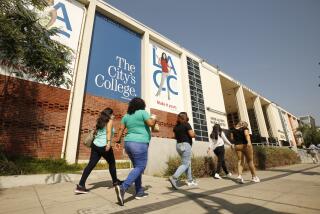Southwest College Deficit Eliminated
SOUTHWEST — The Los Angeles Community College Board this month gave $631,000 to financially strapped Los Angeles Southwest College to wipe out the school’s budget deficit for the 1992-93 academic year.
“This creates a clean slate for us,” said Southwest President Carolyn Williams, who inherited a $1.6-million deficit in the college’s $11.5-million budget when she took over the job in August. “This has been a really turbulent year, but now we have a chance for new opportunity and growth.”
The 6,000-student college, at 1600 W. Imperial Highway, had its share of troubles in 1992. In addition to the deficit, the discovery of a major fault running directly beneath the school resulted in the closure of two buildings whose occupants had to relocate to bungalows on the south end of the campus.
Williams said the move caused expenses the college could not afford. “We had done everything to tighten on money,” she said. “We scaled down utilities, didn’t fill positions that naturally became vacant due to attrition. Ironically, we didn’t have the money to completely shut down the buildings we had to leave because of the fault, (so) it was costing us money to maintain them.”
The money from the seven-member community college board was approved by the presidents of the other schools within the nine-campus district, which includes Southwest, East Los Angeles, Los Angeles City, Harbor, Mission, Pierce, Trade Technical, Valley and West Los Angeles colleges.
The $631,000 came from a district emergency fund, which has paid for such things as the repair of sprinkler systems at City College and new air vents in Valley College’s chemistry labs.
“We felt this qualified as an emergency,” district public affairs officer Fausto Capobianco said. “After Southwest requested the money, the rest of the schools came together on it.”
Although Williams said she is grateful to the district for balancing her budget, she hopes not to be requesting money this time next year.
“We’re assessing our needs right now,” she said. “Basically, we have to implement stronger management, base our growth on stronger classes, plan for the future and allocate resources based on that plan. The bottom line is: We’ve got to direct where we’re going rather than react.”
More to Read
Sign up for Essential California
The most important California stories and recommendations in your inbox every morning.
You may occasionally receive promotional content from the Los Angeles Times.










